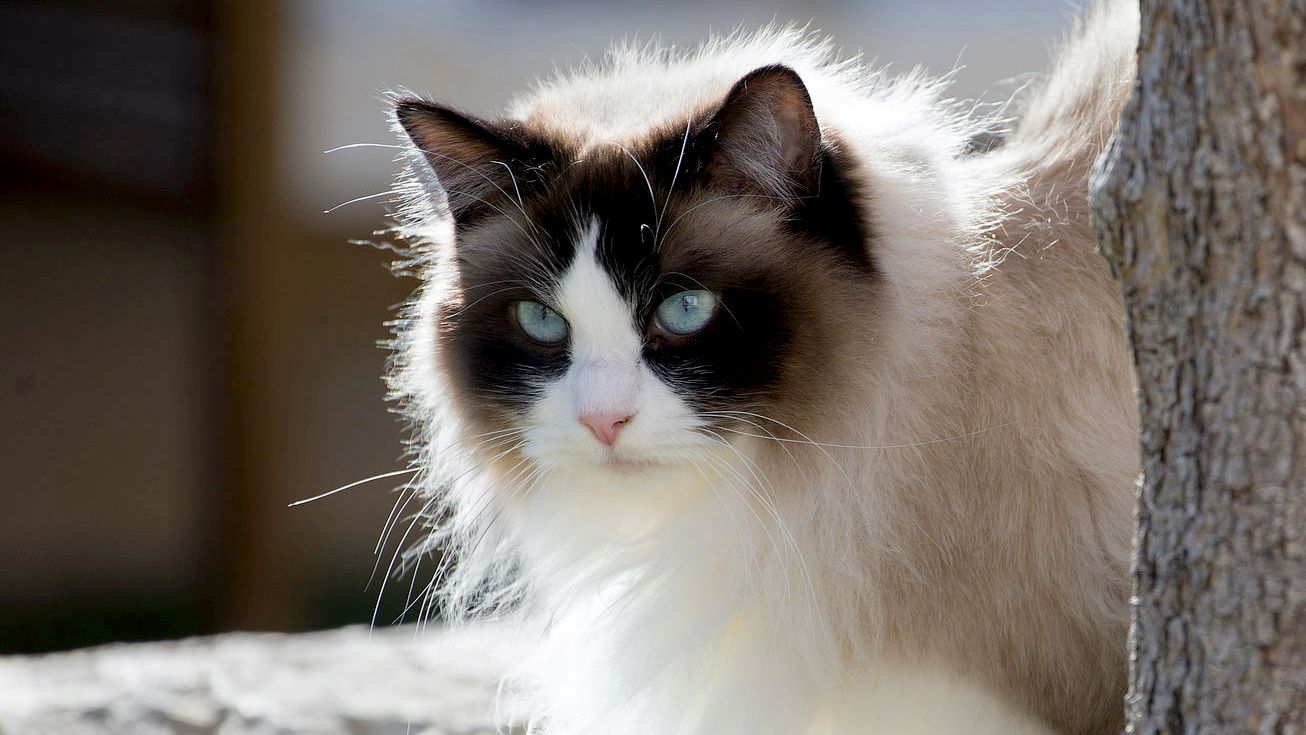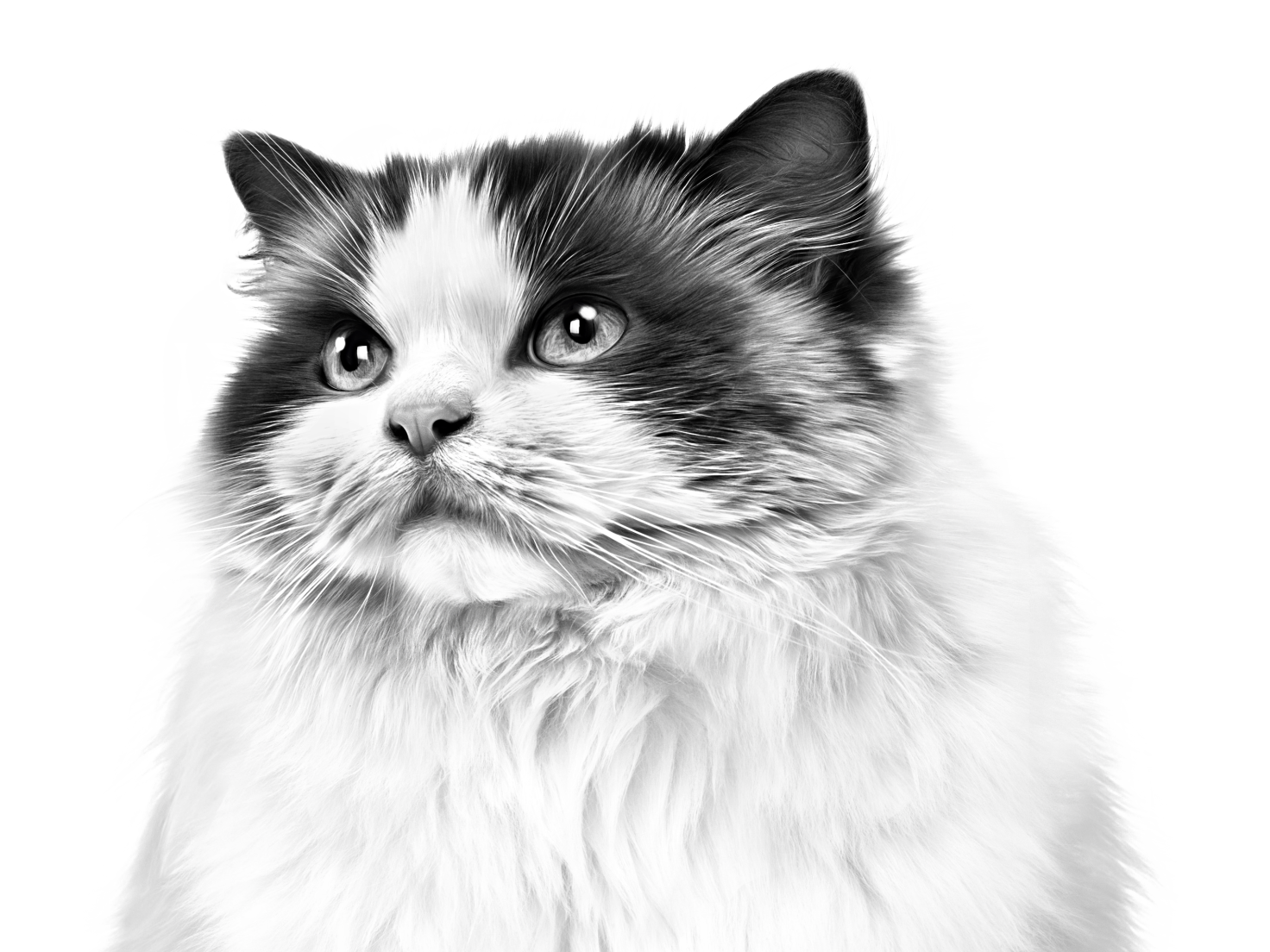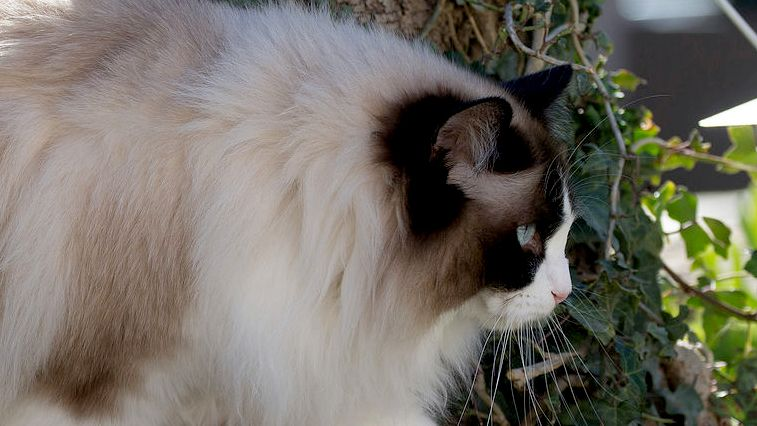Ragdolka
| Samec | Samica |
|---|---|
| Višina | Višina |
| 23 - 28 cm | 23 - 28 cm |
| Teža | Teža |
| 5 - 9 kg | 4 - 6 kg |
| Samec | Samica |
|---|---|
| Višina | Višina |
| 23 - 28 cm | 23 - 28 cm |
| Teža | Teža |
| 5 - 9 kg | 4 - 6 kg |

Spoznajte ragdolko
Vse, kar morate vedeti o pasmi
Pri ragdolki se resnično zdi, da je popolna. Niso samo lepe, ampak so tudi pametne, sproščene in prijazne do praktično vsakogar. Ragdolke imajo celo dolgo življenjsko dobo, saj pogosto živijo do poznih najstniških let.
A kot pasma sploh ne obstajajo zelo dolgo. Ragdolke so bile vzrejene šele v šestdesetih letih prejšnjega stoletja v Združenih državah Amerike in so relativno nove v mačjem svetu. V tem kratkem času pa so postale ene izmed najbolj priljubljenih mačk.
Gre za eno največjih pasem udomačenih mačk; samica lahko doseže do 6 kilogramov, samec pa do 9 kilogramov. Kljub svoji izredni velikosti ragdolke niso posebno energične in so celo precej tihe, zato so običajno primere za večino domov. Znane so tudi po strpnem odnosu do otrok in drugih živali.
Njihova puhasta dlaka, ki spominja na pliš, in podlanka lahko poleg njihove dejanske velikosti povzročita, da se zdijo še večje, kot so v resnici. Ragdolke imajo raznolike vzorce, njihove barve pa lahko segajo od čokoladne, lila in krem do temno rjave, modre in rdeče. Ker pa gre za koničasto pasmo, jim je skupno to, da imajo okončine običajno temnejše obarvane.

1. Obuti maček
Med številnimi različnimi barvami
pasme ragdolk so za eno značilne štiri bele noge. Ta značilnost je tako unikatna,
da imajo takšne mačke svoje ime: ragdolka
z rokavicami.
2. Pes v mačjem kostumu
Pogosto pravimo, da so ragdolke po osebnosti bolj podobne psom,
saj imajo številne vedenjske lastnosti, ki jih pogosteje
pripisujemo psom. Poleg tega, da uživajo v igri prinašanja, vam bodo pogosto
sledile iz sobe v sobo in vas celo pozdravile pri vhodnih vratih,
ko pridete domov.
Zgodovina pasme
Ker izvira iz Kalifornije, ki slovi po svojem sproščenem in ležernem življenjskem slogu, verjetno ni nenavadno, da ima ragdolka tako brezskrben pristop k življenju. Vse se je začelo v šestdesetih letih prejšnjega stoletja, ko se je lokalna vzrediteljica Ann Baker odločila, da bo svojo belo, dolgodlako domačo mačko Josephine križala s samcem s temnejšimi okončinami (ki naj bi bil križanec z birmanko) in tudi s povsem črno mačko. Zanimivo je, da so bile vse te mačke prej potepuške.
Kakorkoli, potomci so bili tako ubogljivi, da se je gospa Baker odločila, da bo poskusila razviti pasmo. In ker so od prijetnih občutkov v rokah ljudi postale tako mlahave, se je odločila, da bo to novo vrsto poimenovala »Ragdoll« (punčka iz cunj).
Pozneje, v sedemdesetih letih prejšnjega stoletja, so drugi rejci, predvsem Denny in Laura Dayton, nadaljevali z razvojem pasme. Njihov cilj je bil formalizirati zadeve in doseči uradno priznanje ragdolke. Vendar je Mednarodna felinološka organizacija (CFA) – največji register rodovniških mačk – ragdolko sprejela šele v začetku devetdesetih let prejšnjega stoletja in jo leta 2000 v celoti priznala.
Ragdolke pa so vsekakor nadoknadile zamujeno. Po podatkih CFA so bile v letu 2020 najbolj priljubljena pasma na svetu. To je bilo tudi drugo leto zapored, ko so osvojile naziv »najboljša mačka«.
1.Glava
2.Dlaka
3.Barva
4.Telo
5.Rep

They can be prone to mouth problems
<p class="Normal1"><span lang="EN-US">Like many breeds, Ragdoll cats can also
suffer with gum and dental issues. These tend to occur when plaque on the
surface of the teeth is allowed to build up. This can induce an inflammatory
reaction at gum level (gingivitis) – and, if it develops into tartar, this can
result in an inflammation of the tooth’s support structures (periodontal
disease). Symptoms can include red gums, pain and bad breath – and, in severe
cases, the resulting toxins can cause damage to the organs. As always,
prevention is better than cure, so daily brushing and regular check-ups are
key. Also, feeding your cat a special dental diet can certainly help. The
action of the kibble rubbing against the teeth will remove some of the plaque
and calcium chelators will prevent the formation of tartar.<o:p></o:p></span></p>
It's important to keep a close eye on their weight
<p class="Normal1"><span lang="EN-US">Due to their sizeable stature, and long
growth period, Ragdoll cats can sometimes experience problems with their joints
and bones. Tell-tale symptoms of this are an abnormal gait, obvious
limping or more general signs of discomfort. The good news is that problems can
be largely prevented from the outset by feeding them a high-quality diet, which
supports healthy growth, and keeping an eye on their weight. As always, stick
to the guidelines on their food packaging and ensure they have enough daily
activity. Also, no unhealthy snacks in-between meals!<o:p></o:p></span></p>
<p><span style="font-size: medium; color: #000000;"></span></p>
And they can be predisposed to a heart condition
<p class="ellipsis"><span lang="EN-US" style="font-size:12.0pt;font-family:
"Calibri",sans-serif;mso-fareast-font-family:Calibri;mso-ansi-language:EN-US;
mso-fareast-language:FR;mso-bidi-language:AR-SA">Ragdoll cats are among the
breeds genetically prone to something called ‘hypertrophic cardiomyopathy’.
This is a heart condition that occurs independently of other cardiac or
systemic disorders and causes a thickening in the walls of the ventricles. The
impact on the normal cardiac function varies, but affected cats may develop
problems ranging from exercise intolerance to a more serious prognosis. As
always, forewarned is forearmed, so have a chat with your vet. Diagnosis can be
done using various techniques and a DNA test is also available. In addition, if
you are thinking of getting a Ragdoll kitten, be sure to ask for the parents’
health certificate.</span><br /></p>
<p class="delete"> </p>
<p class="delete">Your vet may also discuss your Labrador’s weight management as a preventive measure. These simple tools can help you stay on top of potential problems.</p>
Healthy diet, healthier cat

Tailored health nutrition has a fundamental role to play in maintaining the health and beauty of Ragdoll cats. Food provides energy to help with vital functions and a complete nutritional formula for Ragdolls should contain an adapted balance of nutrients. Feeding them in this way will offer a diet that’s neither deficient nor excessive, both of which could have adverse effects on your cat’s health.
Clean, fresh water should be available at all times to support good urinary regularity. Cats are also naturally adapted to eating small servings - between 7 and 10 times a day. Giving them the recommended daily ration of kibble once a day will let your Ragdoll cat regulate their own consumption.
The following recommendations are for healthy animals. If your cat has health problems, please consult your veterinarian who will prescribe an exclusively veterinary diet.
Growth is an essential stage in a kitten’s life. It is a time of big changes, discoveries, and new encounters. When it comes to their energy, protein, minerals, and vitamin requirements, a Ragdoll kitten’s are much greater than those of an adult cat. They need energy and nutrients to maintain their body, but also to grow and build it. A kitten’s growth comes in two phases:
Construction - From Birth to 4 Months:
Weaning is the transition a kitten makes from liquid - or maternal milk - to solid food. This period naturally corresponds to the time when they cut their milk teeth, at 3 to 6 weeks old. At this stage, kittens are not yet able to crunch, so a soft meal (rehydrated kibble or an adapted wet food) helps facilitate the transition between liquids and solids.
Between 4 and 12 weeks after birth, the natural immunity a kitten receives from the mother’s colostrum - or first milk - decreases while the kitten’s immune system gradually develops. This critical time, called the immunity gap, requires a complex of antioxidants, including vitamin E, to help support their natural defences.
Kittens go through an intense and particularly delicate period of growth during which they’re prone to digestive upset. Their diet at this time should not only be rich in energy to meet their essential growth needs but should also contain highly digestible protein for their digestive system that’s still maturing. Prebiotics, such as fructo-oligosaccharides, can also support their digestive health by helping to balance intestinal flora. The result? Good stool quality, all around.
The kitten’s food should contain omega 3 fatty acids - EPA-DHA - which helps support the proper neuro-cerebral development.
Consolidation and Harmonisation - From 4 Months to 12 Months:
From the fourth month, a kitten’s growth slows down, so a food lower in fats is recommended. This is particularly important after a cat is sterilised.
Between 4 and 7 months, a kitten’s milk teeth fall out and are replaced by permanent ones. When the adult teeth have come through, a kitten needs to eat kibble that’s big enough so they’re encouraged to crunch.
Until they’re 12 months old, a Ragdoll kittens’ immune system is still gradually developing. A complex of antioxidants, including vitamin E, can help support their natural defences during this time of big changes, discoveries, and new encounters.
The digestive system matures progressively, with digestive aptitudes reaching full maturity toward twelve months of age. A cat is then able to consume adult food.


A senior cat - one over the age of 12 - may sometimes have difficulties with absorption. To maintain the weight of the ageing cat and minimise the risk of deficiency, they should be given an extremely digestible food filled with essential nutrients.
As they get older, cats increasingly suffer from teeth problems, and in some senior cats, the sense of taste and smell may decline as well, which can lead to a lowered intake of food. To ensure they continue to eat enough, the shape, size, and hardness - meaning texture - of their kibble needs to be tailored to their now potentially more fragile jaw.
Note that the best energy level for any cat still depends on their lifestyle, even those who are ageing. A senior cat that continues to go out regularly will benefit from a diet with a slightly higher fat content. On the other hand, ageing does not reduce an indoor cat’s risk of obesity. Their calorie intake should still be closely monitored. A food with a moderate fat content then may be optimal.
High-quality protein. Contrary to a widely held misconception, lowering the protein content in food brings little benefit in limiting kidney failure. On top of it, older dogs are less efficient at using dietary protein than younger dogs. Reducing the phosphorus content is a good way of slowing down the gradual deterioration of kidney function
A higher proportion of the trace elements iron, copper, zinc, and manganese to help maintain good condition of the skin and coat.
A higher quantity of polyunsaturated fatty acids (omega-3 and omega-6 fatty acids) to maintain the quality of the coat. Dogs can normally produce these fatty acids, but ageing can affect this physiological process.
As they age, dogs increasingly suffer from teeth problems. To ensure they continue to eat in sufficient quantities, the size, shape, and texture of their kibble need to be tailored to their jaw. An adapted kibble shape may help reduce the rate of food intake to help your dog maintain a healthy body weight.

<p>Glede na nežno naravo pasme se bodo mladiči ragdolke vedno najbolje odzvali na pozitivno spodbudo. Gre za zelo inteligentne živali, ki se kmalu naučijo uporabljati mačje stranišče, praskalnike itd. Prav tako se nekatere lahko celo naučijo igrati igre, kot je prinašanje, odvisno od osebnosti vaše ragdolke, . Prav tako so dobra izbira, če imate druge živali, saj se običajno dobro razumejo z drugimi hišnimi ljubljenčki. Zaradi njihove zaupljive narave pa jih je treba še posebej previdno predstaviti vsem obstoječim mačkam ali psom, ki morda ne bodo sprejeli tujca na svojem ozemlju. Iz istega razloga in tudi zato, ker so lahko rahlo nagnjene k nerodnosti, se lastniki včasih odločijo, da bodo ragdolke zadrževali v zaprtih prostorih.</p>
<p>Ko gre za vadbo, je pomembno, da pri ragdolki dosežete pravo ravnotežje. Zaradi svoje velikosti rabijo zmerno količino dnevne aktivnosti, tudi za vzdrževanje telesne teže. Po drugi strani pa ragdolke niso najbolj okretne živali in imajo lahko včasih nekoliko slabo koordinacijo. Če se torej odločite za naložbo v mačje drevo, je pomembno, da izberete takšno, ki ima široke stopnice in ni previsoko. Zagotavljanje številnih priložnosti za aktivno igro pri tleh je na splošno najboljši način za ohranjanje njihove kondicije. Še ena stvar, ki jo je treba upoštevati pri ragdolki, je, da je pod njihovo gosto dlako težko opaziti naraščajoč obseg trebuha. Zato jih lahko občasno stehtate. Ker so kot lutke iz blaga, jih to ne bo motilo.</p>
<p>Morda vas bo presenetilo, da ragdolke dosežejo polno velikost in razvitost dlake šele pri štirih letih. Ko se to zgodi, ima ragdolka bujno in gosto dlako s svilnato teksturo, ki jo včasih primerjajo z zajčjo. Ker imajo malo podlanke, so manj nagnjene k odpadanju dlake, a vseeno potrebujejo krtačenje ali česanje vsaj enkrat ali dvakrat na teden, da se znebimo odmrle dlake. To je še posebej pomembno med sezono izpadanja dlak pri ragdolkah. Pogosto se pojavi vprašanje, kako iz dlake ragdolke odstraniti vozle. Trik je v tem, da jih nežno razčešete z glavnikom s širokimi zobmi in po potrebi uporabite malce kokosovega olja, da razrahljate vozle. Vendar bodo potem potrebovale kopel! Poleg tega je treba redno pregledovati ušesa, po potrebi striči nohte in vsak dan umivati zobe, če je to mogoče.</p>
<p>Glede na nežno naravo pasme se bodo mladiči ragdolke vedno najbolje odzvali na pozitivno spodbudo. Gre za zelo inteligentne živali, ki se kmalu naučijo uporabljati mačje stranišče, praskalnike itd. Prav tako se nekatere lahko celo naučijo igrati igre, kot je prinašanje, odvisno od osebnosti vaše ragdolke, . Prav tako so dobra izbira, če imate druge živali, saj se običajno dobro razumejo z drugimi hišnimi ljubljenčki. Zaradi njihove zaupljive narave pa jih je treba še posebej previdno predstaviti vsem obstoječim mačkam ali psom, ki morda ne bodo sprejeli tujca na svojem ozemlju. Iz istega razloga in tudi zato, ker so lahko rahlo nagnjene k nerodnosti, se lastniki včasih odločijo, da bodo ragdolke zadrževali v zaprtih prostorih.</p>
<p>Ko gre za vadbo, je pomembno, da pri ragdolki dosežete pravo ravnotežje. Zaradi svoje velikosti rabijo zmerno količino dnevne aktivnosti, tudi za vzdrževanje telesne teže. Po drugi strani pa ragdolke niso najbolj okretne živali in imajo lahko včasih nekoliko slabo koordinacijo. Če se torej odločite za naložbo v mačje drevo, je pomembno, da izberete takšno, ki ima široke stopnice in ni previsoko. Zagotavljanje številnih priložnosti za aktivno igro pri tleh je na splošno najboljši način za ohranjanje njihove kondicije. Še ena stvar, ki jo je treba upoštevati pri ragdolki, je, da je pod njihovo gosto dlako težko opaziti naraščajoč obseg trebuha. Zato jih lahko občasno stehtate. Ker so kot lutke iz blaga, jih to ne bo motilo.</p>
<p>Morda vas bo presenetilo, da ragdolke dosežejo polno velikost in razvitost dlake šele pri štirih letih. Ko se to zgodi, ima ragdolka bujno in gosto dlako s svilnato teksturo, ki jo včasih primerjajo z zajčjo. Ker imajo malo podlanke, so manj nagnjene k odpadanju dlake, a vseeno potrebujejo krtačenje ali česanje vsaj enkrat ali dvakrat na teden, da se znebimo odmrle dlake. To je še posebej pomembno med sezono izpadanja dlak pri ragdolkah. Pogosto se pojavi vprašanje, kako iz dlake ragdolke odstraniti vozle. Trik je v tem, da jih nežno razčešete z glavnikom s širokimi zobmi in po potrebi uporabite malce kokosovega olja, da razrahljate vozle. Vendar bodo potem potrebovale kopel! Poleg tega je treba redno pregledovati ušesa, po potrebi striči nohte in vsak dan umivati zobe, če je to mogoče.</p>
7/7
Vse o ragdolkah
Ragdolka polno zrelost doseže
pri štirih letih starosti, normalna pričakovana življenjska doba pa je od 12 do 17
let. To pomeni, da je povprečna življenjska doba ragdolke približno 14 do 15 let.
Vendar pa lahko s pravilno prehrano in dobro veterinarsko oskrbo včasih dosežejo
veliko več let kot to.
Samo ena, barve ragdolk pa so
lahko zelo različne, od rdeče, temno rjave in čokoladne do modre, lila in krem. Še eno
zanimivo dejstvo o ragdolkah je,da so temnejše okončine
najbolj priljubljena barva. Obstajajo pa tudi različni
vzorci. Vse pa spadajo pod isto pasmo.
Viri
1 – Veterinary Centers of America https://vcahospitals.com/
2 – Enciklopedija o mačkah Royal Canin. Izdaji 2010 in 2020
3 – Banfield Pet Hospital https://www.banfield.com/
4 – knjiga izdelkov Royal Canin BHN
Všečkajte in delite stran